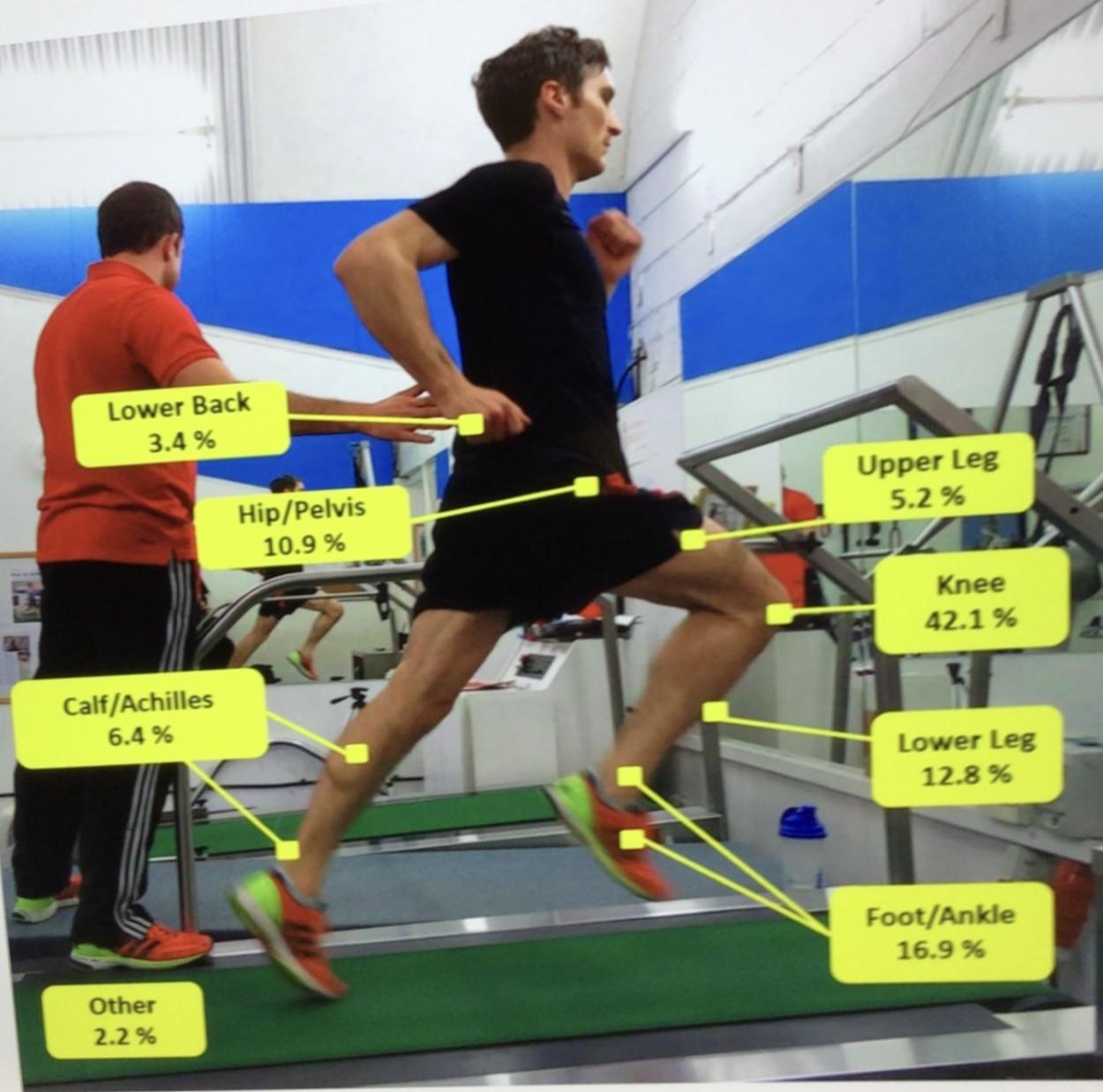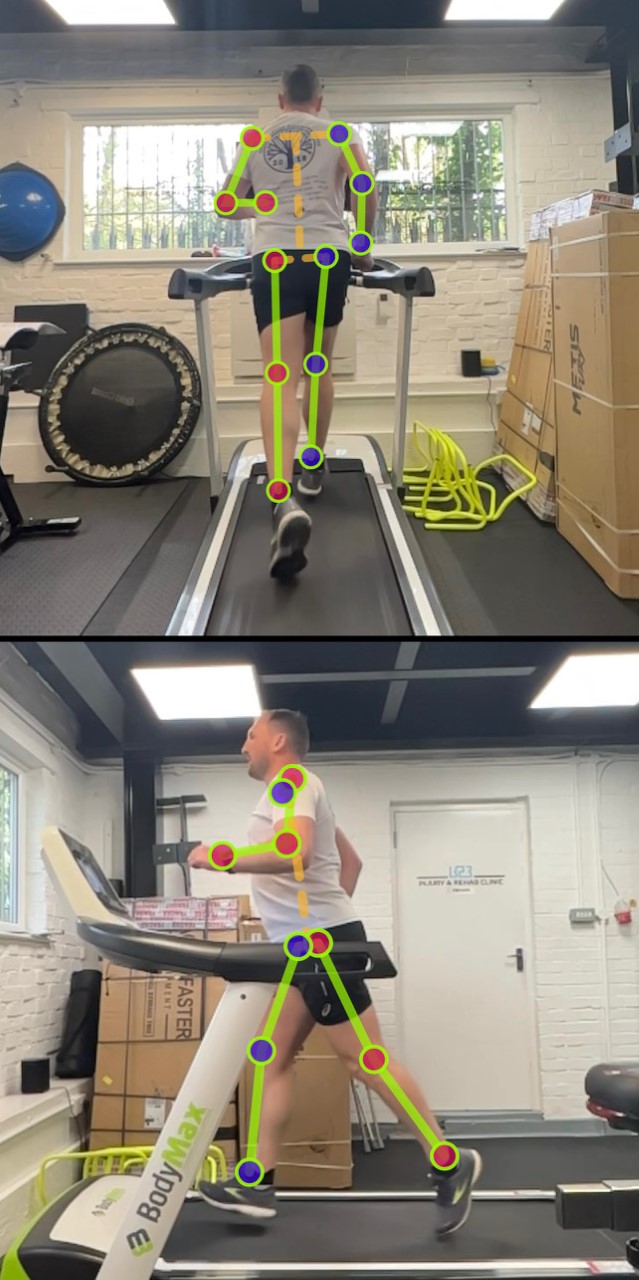Since opening my clinical doors back in 2013, I naturally have been led towards runners as a specialty. In our local area, runners seem to thrive much more, likely due to our lovely coastline and lack of major hills. In that time, I’ve grown more and more of an understanding of the mentality of a runner, areas at high risk of injury, the best way to cross train around a runners’ weekly regime, and the movement patterns of a runner both in how to reduce risk of injury and how to improve their performance.
Injury Risks
Unfortunately with any sport or exercise there come injury risks. With runners as you can imagine they are predominantly in the lower limbs, but we can get lower back and shoulder issues too. The picture shown details the likelihood of each area of injury and as you’ll notice, your knees can take a bit of a beating! From IT band issues, to patellar tendon pain, to cartilage problems and everything in between. The trend with runners and injuries is often that the pain you are feeling comes on gradually and slowly, without any real obvious reason. The simple reason for this is that running isn’t really known to be a high intensity/impact sport, so the likelihood of a traumatic injury is quite low which then leads to chronic conditions, in particular your tendons. The best thing you can do to avoid these types of things building on you are:
- A good nights sleep, regularly
- Enough calories, especially at longer distance running (no fuel = engine breaks down)
- Cross training, and by that I don’t mean another form of cardio
- Correct running form
- Gradual increase in your miles

Runner Mentality
I think it should be globally known that the vast majority of runners choose to run for their mindset more than their fitness level. If I have a runner come into the clinic with an injury and I advise them not to run for a period of time, I can almost guarantee that the first question won’t be “what exercise can I do instead?” but rather “how long until I can run again?” as if to say there are no other options. Running to some individuals can become almost an addiction, a way to escape from the stresses of home or work life. For some it’s a way to find their own therapy; rather than escaping their stress they use running to evaluate life, problems and goals and how to address them. Almost like an independent brainstorm within the brain. To these people, I congratulate you. You’ve found a way not only to be physically fit but also mentally.
Runner Cross training
Now cross training does not mean more cardio work. As much as you’ve found your type of exercise and don’t want to veer from it, when it comes to longer distance running I can’t advise you enough to follow these simple tips.
Yoga, or any form of mobility program just once a week can make such a difference! A good 30-45 minutes focusing on your lower body and lower back will really help you avoid running with stiff legs, not to mention in day-to-day life. Now I’m not trying to make you a gymnast, after all as an average runner you will only really flex and extend your joints by no more than about 30 degrees, but flip that around. If your muscles are ONLY moving the joints 30 degrees through movement, it becomes a learned pattern of range of movement. Those joints start to adapt to that movement and not the end ranges, and decide you don’t need them for that range and begin tightening themselves. Avoid that simply by moving every once in a while, and I don’t mean static stretches every day. Static stretches increase flexibility, sure, but they can also lead to weakness in the muscles. Trust me, once a week going through a movement program will be all you’ll need to help you be a bit more comfortable in your training.
Strength is another big emphasis in your training. In fact, I’d rate this above your movement. A lot of runners may take this on board to mean a bodyweight program in their living room; Squats, Lunges, perhaps some calf raises on your steps. I’m sorry to say that, for the majority of you, that’s just not good enough. If you have access to a gym or a good amount of weights at home then I’d advise you to put them to good use. Deadlifts, Back squats, Single leg calf raises while holding a weight, Hamstring curls, Romanian deadlifts, Hip thrusts and Bulgarian split squats just off the top of my head are some exercises that you’d find tough to do effectively without any weight. You gain strength by adding load, it’s as simple as that. If you feel you need more guidance in this field then please do get in touch, we can bring you in and go through some appointments designing you a strength program for your ability level. This is something else, as with mobility, that as a runner I would advise you do once a week.
Movement patterns
Now this is a big one. The way you run ultimately makes the difference between your running lifestyle being a smooth and injury free one until your later life, or a constant hurdle of problems and never really seeing a change in your speed or effort level.
The problem here is that it cannot be addressed independently. If you run long distances and have recurrent injuries, or are planning to up your mileage, I think it would be wise for you to be assessed correctly for any risk factors and nip them in the bud. Educating you to change your gait takes weeks, maybe even months, but with your persistence to follow the information given in the right format can change your abnormalities for good. There’s no such thing as a perfect runner, but following a strict and comprehensive protocol can steer you away from the major imperfections at the very least. The way I analyse you takes up to 45 minutes, so however you choose to be assessed please bear in mind that there’s no shortcut. To cover all parameters you need to ensure you see the right practitioner with the right knowledge in what to look for.



